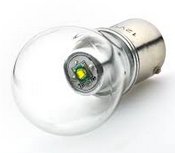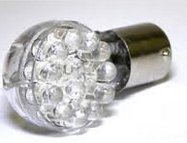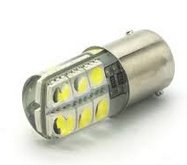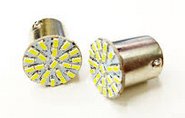Ever just wanted to know what bulbs to install in your late model Bug?
…or you were wondering about LED bulb versus conventional tungsten bulb brightness.
I put together this handy table with hopefully everything you ever wanted to know about your light bulbs.
Below are a few more notes about LED conversions for your Beetle and what you may wish to be aware of.
1975 VW Bug – North America – Bulb Table – Front to Rear
Tungsten/Conventional Bulbs
| Where | Model | Wattage | Lumen |
| Headlamp | 6014 | 60/55 | 1120 |
| Front Turn/Park | 1157 | 27/8 | 402/38 |
| Side (Front Parking) | 1895 | 4 | 25 |
| Instrument/Oil/Gen/Turn | 281 | 2 | 15 |
| Heater Controls (Floor Light) | 74 | 1.4 | 9 |
| Interior | 6411 | 10 | 100 |
| Rear Turn | 1156 | 27 | 300 |
| Rear Brake/Park | 1157 | 27/8 | 402/38 |
| Side (Rear) | 97 | 9 | 50 |
| Backup | 1156 | 27 | 300 |
| License | 89 | 8 | 75 |
Regarding LED bulbs for your bug: consider the consequences in certain locations.
Something as benign as an interior cabin lamp is a pretty simple substitution, but in other applications – some LED conversions may not work as you might expect.
- Turn Signals – Some turn signal relays depend on the resistance of tungsten bulbs in order to operate. If you use a standard relay, bulbs may “fast flash”, or fail to operate all together. You may need to switch relays to make this work.
- Speedometer backlights – LED’s generally do not emit light in a sphere like a tungsten bulb, so this can cause a poor gauge lighting effect using bulbs from certain vendors.
- Oil Pressure Lamp – An incandescent lamp here is helpful, as the bulb may wink or glow dim at idle – indicating an issue. LED’s are rather binary, meaning they are generally operating as “on” or “off” – there is seldom a dim output from an LED, not as you may see from an incandescent.
- Alternator Lamp – In order for a late model alternator to wake up and produce output, the alternator magnetic field becomes “excited” by the flow of electricity through the bulb and this starts the output. This can be worked- around by changing the source of where the alternator gets excited from, such as input from the “start” keyswitch position. (often stolen from the second small terminal on the starter solenoid. Additionally – the “non-dim” situation from the Oil Pressure topic applies here as well. In the case of an alternator, a dim bulb can indicate trouble afoot with the charging system. Without this visual cue, you could wind up in trouble when you are out for a Sunday cruise.
- Headlamps – I don’t any practical experience here – but the interwebs state endurance is an issue for bulbs without fans. Fans!? – that to me just sounds like a failure mode I don’t wish to have on a headlight. Other posts suggest the output tends to glare or be not as bright as the originals. The consensus seems to suggest a glass Hella enclosure with a halogen or xenon bulb that meets DOT certification.
- General Topic – LED bulbs can be very directional, when the original design for the lamp fixture called for a 360 degree illumination. Take these 1156 “compatible” bulbs for instance:




None of these bulbs will have the same illumination characteristics as a tungsten #1156 (or each other for that matter). In a reverse lamp or license tag bulb, that may be ok. However – if there is a semi-truck following your bug, and the driver of the truck mistakes your brake lamps for parking/clearance lamps…. not a good situation.
I suppose the old adage is still true – “If it ain’t broke, don’t fix it”
If anybody has done a full or partial LED swap on a bug, I’d like to know what bulbs you used, and any mods you had to do. Leave a message in the comments below!
